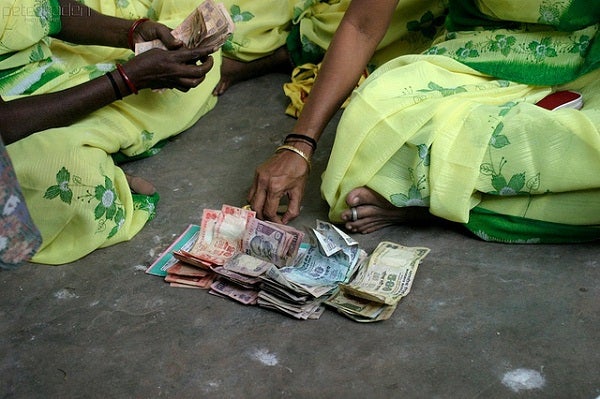How Can Group Loans be Provided more Responsibly?
The popularity of the joint liability group (JLG) loan, attributable to its ability to deliver credit to households that lack collateral while achieving near-zero default rates, has led to the establishment of a large microcredit sector in many countries including India. However, repayment (or its lack thereof) presents an incomplete picture in assessing whether a JLG loan actually helped a customer achieve her original goals or improve her financial situation.
For many smallholder farmers, for example, who account for a large customer segment for JLG loans, income is often volatile and dependent upon external factors, such as the price of harvested crops or rainfall patterns. The repayment plans for typical JLG loans, however, are structured and not very flexible. They require weekly or monthly payments for the life of the loan. The farmer’s obligation to make these structured repayments according to this schedule is akin to a highly leveraged position in the stock market – very risky. In a bad month when income from the sale of produce is low, repaying a loan might only be possible by making sacrifices such as eating less or lower quality food, working more hours as a part-time casual laborer, or parting with a cow for much less than it is worth. In a case like this, the farmer may have successfully repaid a loan, but at what cost? In this way, repayment behavior does not necessarily signify whether a loan enhanced a household’s financial position. At worst, it may shroud whether the loan left the household worse off.

Rather, the “interaction” of financial products with the natural cash flows of a household is crucial to the product’s efficacy in meeting household objectives. Based on a household’s characteristics and its financial situation at the time and point of a product’s sale, it is possible to evaluate the “goodness of fit” or the “suitability” of a household, in terms of anticipated outcomes. Financial service providers such as banks and microfinance institutions may naturally be in a stronger position to advise their customers on appropriate products and to steer them away from products that will likely cause them harm. Recognizing this provider obligation, The Reserve Bank of India in its recent draft charter of customer rights includes a Right to Suitability, which states that financial products offered should be appropriate to the needs of the customer and based on an assessment of the customer’s financial circumstances and understanding.
In light of this new regulatory stance on customer protection, the IFMR Finance Foundation (IFF) seeks to understand implications for providers of JLG loans, which in India are most prominently microfinance institutions (MFIs). By identifying sets of household characteristics that are fundamentally unsuited for a JLG loan, IFF will develop guidelines that would act as a “do-no-harm” filter at the point and time of sale.
Through a longitudinal survey administered in Tamil Nadu, India, a sample of 200 JLG customers and comparable non-customers will be interviewed each month for the duration of their loan. Field investigators will gather detailed information on a variety of household characteristics such as asset holding, occupational cash flows, and consumption patterns, as well as household behavior such as instalment repayment management, coping mechanisms in the face of shocks, and dynamics within JLG groups.
The primary analysis will focus on the determinants of financial stress related to the changing composition of household financial portfolios, paying close attention to the role of the JLG loan in reducing or enhancing overall financial stress. This rich dataset will also enable supplementary investigations on household economic behavior including how households use financial services to meet expenses, make investments, and manage shocks.
The findings from this study, funded by the CGAP Clients at the Center Research Fund, will set a precedent and provide a model for how JLG loan providers can be more responsible and better function in the interest in of the customers they serve. Study results are expected to be available by mid-2016.




Comments
It’s very good indeed to see
It’s very good indeed to see this important research being planned. I especially like the second para of this blog, which nicely sums up why we desperately need to do something about group loan repayment inflexibility.
I’d like to take advantage of this posting to push for a related idea. Group-based microlending has always kept costs low by using a ‘one size fits all’ approach in which field workers don’t have to use their judgment much. To protect borrowers from taking on too much debt within such a simple system it was hoped that joint liability would ensure that the size of the loan for any individual borrower would be vetted for ‘suitability’ by her peers. Well, MFIs have learnt that joint liability doesn't work – it makes no business sense to penalize your best customers for the failures of your worst ones – and in many mature markets (like Bangladesh) the MFIs have sensibly abandoned joint liability.
But that leaves no mechanism for ensuring that clients don’t borrow too much, and with pressure on fieldworkers to maximize portfolio size and surpluses, many clients are persuaded to borrow too much, and are more or less abandoned when they inevitably get into trouble. This is bad, sometimes very bad.
Now, this proposed new research will help, but my fear is that cost pressures and unsophisticated field staff will mean that many MFIs will not be able (or will not be inclined) to carry out even the most basic checks on ‘suitability’. What we need are some basic safeguards that will work even in a ‘one size fits all’ tradition.
The first priority should be to outlaw the barbaric but still all-too-common MFI practice of insisting that clients borrow continuously. Forcing clients to be always in debt multiplies the chances of their getting into trouble with their loans, because it means they go on borrowing even when their better natures are warning them against doing so. Please can we have a CGAP campaign to rid the MF world of this monstrosity?
If we achieve that, the ground will be clear for us to go on and get rid of inflexible repayment terms altogether. There is plenty of evidence to show that fixed periodic payments are not a prerequisite of good repayment. My own experiments have been carried out at SafeSave (safesave.org) where since 1996 we have been providing poor slum dwellers loans that have neither a fixed term nor a fixed repayment schedule, but which enjoy performance results on a par with or better than conventional group-based lending.
I commend the project and
I commend the project and eager to see the outcomes/learning's. Also i have the following observations to add:
Group loan customers are forced to borrow perpetually due to the following aspects:
1. Clients have no avenue for saving money as per their convenience and they see loan repayment as alternative to savings so that saving discipline is maintained in a different form.
2. With PE investors demanding higher returns and lack of social investors to invest in MFIs has pushed the MFIs crazily running for numbers to meet investor expectation to ensure study supply of capital for the increased business levels.
3. In India the regulatory stances such as margin cap,active loans, income ceiling also have contributed for blind push for loans among customers ignoring needs, purpose and impact on their living.
All current evils of group lending can be got away if MFIs turn themselves into small banks and they are permitted to collect savings by Regulators.
Do you know about credit
Do you know about credit scroing tools developed for Savings groups who want to take a loan? Suitable tools that measures the risk of the group as a unit.
Add new comment